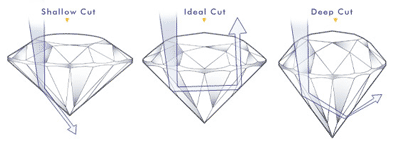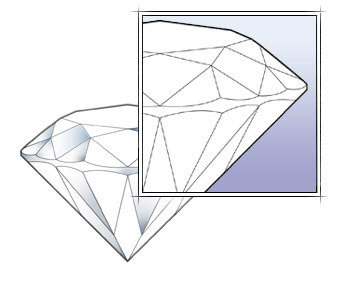A diamond's weight is the simplest of its characteristics to measure and is used to calculate one aspect of a diamond's value. The word "carat" is derived from the "carob" bean, which was first used to determine a diamonds weight. One carat is a unit of measure; equal to a fifth of a gram (Note: One-fifth of a gram of gold is equal in weight to a one carat stone, a 5 carat diamond is equal to 1 gram.). Each carat is divided into 100 points. For example, think of a dollar, having 100 cents or parts, i.e. quarter carat (0.25ct.) has 25 points, a half a carat (0.50ct.) has 50 points and a 1.00 carat has 100 points.
A larger diamond is more valuable simply because it is found less frequently in nature than a smaller diamond. As it is more rare, the price per carat increases as the diamond gets larger, however, carat weight has no bearing on diamond color, clarity, or cut.
The majority of diamonds appear white in color, however, there are subtle differences, which Color Grading is intended to define. The Gemological Institute of America (GIA) Grading Laboratories use a color scale that ranges from D, E, F "colorless" to Z "strong yellow". The "colorless" diamond is more valuable than a diamond with a "hint of color to faintly yellow", although the grades between colorless and the "near colorless" G, H, I, and J can really only be truly appreciated by making a side by side comparison between diamonds of near equal size and shape.
Diamonds of color grade K and lower have enough yellow color to be visually apparent, yet can still be considered a choice by some as their cost is much less than higher color grade stones.
The way a diamond is cut, it's shape, as well as symmetry, and proportions, has a direct influence on the brilliance of a diamond.

The precision of the cut dictates the amount of light that the diamond will refract and reflect. The more expertly it has been cut, the greater its brilliance will be. When a diamond is cut to Ideal proportions, light is internally reflected from one facet to another and then dispersed through the crown, or top/table of the diamond. If the cut is too deep, then some refracted light will escape through the opposite side of the pavilion, or bottom of the diamond. If the cut is too shallow, then some light will escape through the pavilion before it can be reflected. A well-cut diamond is comprised of facets with the correct angles perfectly placed to maximize the diamond's brilliance. It is the quality of the cut and final polish that reveals the beauty of a diamond.
Clarity Grading is intended to describe, to what degree and under what conditions a diamond is free of naturally occurring inclusions or blemishes.
A diamond is carbon that crystallizes in the earth for millions of years. During the crystallization process a variety of inclusions in the crystalline structure may occur. These inclusions, described by terms such as: cloud, feather, dark inclusions, etc., are found in almost every diamond and are generally caused by conditions present when the diamond was formed, though blemishes may also occur during the polishing process. The grading for clarity measures how many or few of these flaws are found, and gives special consideration to where they are located in the diamond.


Since nature makes nothing absolutely pure or perfect, those diamonds with few inclusions are most rare and command a higher price. The industry wide scale ranges from the low end or imperfect I-3, to the best "gem quality", the internally flawless IF/FL.
The cost of a diamond is determined by:
Is color the most important consideration for you? Perhaps it is clarity? Is your desire a one-carat ideal cut or would you choose some desirable combination of these cost-determining factors to arrive at the perfect diamond for you?
The price per carat is higher for a 1.00 carat diamond than for a .75 carat diamond of equal cut, color and clarity. An example of this might be a 1ct. VS2 G color diamond at a cost of $6700 per carat. = The total cost would be $6700 compared to a .75ct. VS2 G color diamond at $4600 per carat as .75 X $4600 = $3450. Remember that a round 1.00 carat, VS2, G color with a good cut is more expensive than a .75 carat stone of equal clarity, color and cut. This price difference of equal quality diamonds of different weights is determined by the price per carat for that size range. The bigger the diamond, the higher the color and clarity grade and the better the cut the more expensive the diamond cost.
| Carat Weight | Clarity Color | Price per Carat | Stone Price |
|---|---|---|---|
| 1.00ct | VS2 G | $6700.00 | $6700.00 |
| .75ct | VS2 G | $4600.00 | $3450.00 |
The Art Of Jewels can provide you with a competitive selection of diamonds for your comparison but ultimately the choice will be based on your budget and personal preference for a given diamonds' overall appeal.
A diamond certificate is a document from an independent testing laboratory. That provides all the specifics regarding the diamond: shape, measurements, carat weight, color, and imperfections or inclusions. It also includes certain characteristics of the diamond's cut and any other comments regarding the specific diamond. Of equal importance is a numerical ID that identifies your diamond as being connected with its certificate.
The Art Of Jewels will provide a certificate for a single diamond with a weight of .70ct and above, a color grade of "H" or higher, and a clarity grade of "VS2" or higher when set in an engagement ring of your choice.
Reputable diamond certification laboratories include Gemological Institute of America (GIA), The European Gemological Laboratory (EGL), The American Gem Society (AGS), The International Gemological Institute (IGI), and Hoge Road voor Diamant or Diamond High Council (HRD). These grading laboratories all utilize the same methodology of diamond grading including evaluating a specific diamond's 4c's by three separate gemologist. The final grade is determined by a majority opinion as to cut, color, clarity and carat weight.
There are other laboratories that exist that offer diamond grading certificates. They vary in reputation and accuracy and you should be advised to evaluate their credentials before choosing to entrust your diamond with them.
A diamond certificate is a document from an independent testing laboratory. That provides all the specifics regarding the diamond: shape, measurements, carat weight, color, and imperfections or inclusions. It also includes certain characteristics of the diamond's cut and any other comments regarding the specific diamond. Of equal importance is a numerical ID that identifies your diamond as being connected with its certificate.
The Art Of Jewels will provide a certificate for a single diamond with a weight of .70ct and above, a color grade of "H" or higher, and a clarity grade of "VS2" or higher when set in an engagement ring of your choice.
Reputable diamond certification laboratories include Gemological Institute of America (GIA), The European Gemological Laboratory (EGL), The American Gem Society (AGS), The International Gemological Institute (IGI), and Hoge Road voor Diamant or Diamond High Council (HRD). These grading laboratories all utilize the same methodology of diamond grading including evaluating a specific diamond's 4c's by three separate gemologist. The final grade is determined by a majority opinion as to cut, color, clarity and carat weight.
There are other laboratories that exist that offer diamond grading certificates. They vary in reputation and accuracy and you should be advised to evaluate their credentials before choosing to entrust your diamond with them.